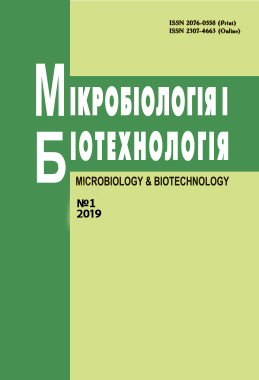ЗДАТНІСТЬ LACTOBACILLUS PLANTARUM ОНУ 12 ДО ВИЖИВАННЯ В УМОВАХ ҐРУНТУ
DOI:
https://doi.org/10.18524/2307-4663.2019.1(45).155065Ключові слова:
молочнокислі бактерії, ґрунт, ризосфера, збереження життєздатностіАнотація
Мета роботи: встановити тривалість збереження життєздатності бактерій Lactobacillu splantarum ОНУ 12 в умовах ґрунту. Матеріали і методи. Культуру бактерій L. plantarum ОНУ 12 КУО/мл вносили у чорноземний і торф’яний ґрунти у двох варіантах – без рослин та з тест-рослинами Kalanchoe daigremontiana Mill до досягнення концентрації 108 КУО/г. Через кожні чотири дні здійснювали контроль чисельності лактобацил шляхом висіву мікробіоти ґрунту на агаризоване середовище MRS та вивчення фенотипових ознак і подальшої ідентифікації методом полімеразної ланцюгової реакції. Результати. Лактобацили найдовше зберігали життєдіяльність у ризосфері рослин, які культивували у чорноземному ґрунті: на 44-й день експерименту їх чисельність становила (2,8±0,4)х102 КУО/г, у ґрунті без рослин зберігалися щонайменше 36 діб. У торф’яному ґрунті лактобацили виживали у найменший термін і не виявлялися після 32-ї доби, а у ризосфері рослин у торф’яному ґрунті – щонайменше 36 діб. Висновок. В залежності від ґрунту та присутності рослин лактобацили здатні зберігати життєздатність до 44 діб.
Посилання
Korotaieva NV, Limanska NV, Basiul OV, SergeevaZh, Ivanytsia VO. The survival of lactobacilli and agrobacteria introduced into plant phyllosphere. Biolohichni studii. 2015. 9(2): 23 – 30(in Ukrainian).
Rzhevskaia VS, Teplytskaia LM, Oturyna YP.Colonization of cucumber root rhizoplane with microorganisms from microbial preparation «Embiko». Visnyk Dnipropetrovskoho universytetu. Biolohiia. Medytsyna.2013. 4(2): 63–70 (in Russian).
BaffoniL, AccorsiM, GaggiaF, BosiS, MarottiI, BiavatiB, GioiaDD, Dinelli G. Inoculation with “Effective Microorganisms” of Loliumperenne L.: evaluation of plant growth parameters and endophytic colonization of roots. Environ EngManag J. 2012: 11(S144): https://pdfs.semanticscholar.org/81dd/5b69abad3187c14c63a1 5ddf50a74add53c4.pdf
Chen YS, Yanagida F, Shinohara T. Isolation and identification of lactic acid bacteria from soil using an enrichment procedure. Lett ApplMicrobiol. 2005. 40(3): 195–200.
DeMan JC, Rogosa M, Sharpe ME. A medium for the cultivation of lactobacilli. J Appl Bacteriol. 1960. 23: 130–135.
Ekundayo FO. Isolation and identification of lactic acid bacteria from rhizosphere soil of three fruit trees, fish and ogi. Int J Curr Microbiol Appl Sci. 2014. 3: 991–998.
Fhoula I, Najjari A, Turki Y, Jaballah S, Boudabous A, Ouzan H. Diversity and antimicrobial properties of lactic acid bacteria isolated from rhizosphere of olive trees and desert truffles of Tunisia. Biomed Research International. 2013: doi: 10.1155/2013/405708
Gruneberg H, Oschmann C, Dunya S, Ulrich C. Improving green roofs and rail road greening systems using Bacillus subtilis and Lactobacillus plantarum. Communications in agricultural and applied biological sciences. 2006. 72: 121– 130.
Higa T, Kinjo S. Effect of lactic acid fermentation bacteria on plant growth and soil humus formation. In: Proceedings of 1st Intern Conf on Kyusei Nature Farming, KhonKaen, Thailand. 1989: 13–16.
Hoda AH, Yomna AM, Shadia MA-A. In vivo efficacy of lactic acid bacteria in biological control against Fusarium oxysporum for protection of tomato plant. Life Science J. 2011. 8: 462–468.
Limanska N, Ivanytsia T, Basiul O, Krylova K, Biscola V, Chobert JM, Haertlé T. Effect of Lactobacillus plantarum on germination and growth of tomato seedlings. Actaphysiologiae plantarum. 2013. 35(5): 1587–1595.
Limanska NV, Sokolova NV, Sudak AA, Galkin MB, Ivanytsia VO. Effect of Lactobacillus plantarum on growth characteristics of wheat in hydroponics and soil. Microbiology and Biotechnology. 2018. 3(43): 36–49.
Oyeyiola GP, Arekemase MO, Sule I, Agbabiaka T.O. Rhizosphere bacterial flora of Okro (Hibiscus esculentus). SciInt (Lahore). 2013. 25(2): 273– 276.
Torriani S, Felis GE, Dellaglio F. Differentiation of Lactobacillus plantarum, L. pentosus and L. paraplantarum by recA gene sequence analysis and multiplex PCR assay with recA gene-derived primers. Appl Environm Microbiol. 2001. 67(8): 3450–3454.
Yanagida F, Chen YS, Shinohara T. Searching for bacteriocin-producing lactic acid bacteria in soil. J Gen Appl Microbiol. 2006. 52(1): 21–28.
YanagidaF, Srionnual S, Chen YS. Isolation and characteristics of lactic acid bacteria from Koshu vineyards in Japan. Lett Appl Microbiol. 2008. 47(2): 134–139.
##submission.downloads##
Опубліковано
Номер
Розділ
Ліцензія
Авторське право (c) 2019 Мікробіологія і біотехнологія

Ця робота ліцензується відповідно до Creative Commons Attribution-NonCommercial 4.0 International License.
Автор передає журналу (університету) на безоплатній основі невиключні права на використання статті (на весь строк дії авторського права починаючи з моменту публікації, розміщення статті на веб-сторінці журналу, в репозитарії відкритого доступу) без одержання прибутку; на відтворення статті чи її частин в електронній формі (включаючи цифрову); виготовлення ії електронних копій для постійного архівного зберігання; виготовлення електронних копій статті для некомерційного розповсюдження; внесення статті до бази даних репозитарію; надання електронних копій статті в доступі мережі інтернет.
Автор гарантує, що у статті не використовувалися статті або авторські права, які належать третім особам; гарантує, що на момент розміщення статті на веб-сторінці, в репозитарії ОНУ лише йому належать виключні майнові права на статтю, що розміщується; майнові права на статтю ні повністю, ні в частині нікому не передано (не відчуджено), майнові права на статтю ні повністю, ні в частині не є предметом застави, судового спору або претензій з боку третіх осіб.
Автор зберігає за собою право використовувати самостійно чи передавати права на використання статті третім особам.
Автор надає журналу право на використання статті такими способами:
переробляти, адаптувати або іншим чином змінювати її за погодженням з автором; перекладати статтю у випадку, коли стаття викладена мовою іншою, ніж мова, якою передбачена публікація у виданні. Якщо журнал виявить бажання використовувати статтю іншими способами: перекладати, розміщувати повністю або частково у мережі інтернет, публікувати статтю в інших, в тому числі іноземних виданнях, включати статтю як складову частину до інших збірників, антологій, енциклопедій тощо, умови оформлюються додатковою угодою.
Автор підтверджує, що він є автором (співавтором) цієї статті; авторські права на дану статтю не передані іншому видавцю; дана стаття не була раніше опублікована у будь-якому іншому виданні до публікації її журналом.
Публікація праць в Журналі здійснюється на некомерційній основі. Комісійна плата за оформлення статті не стягується.

